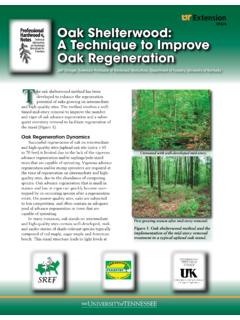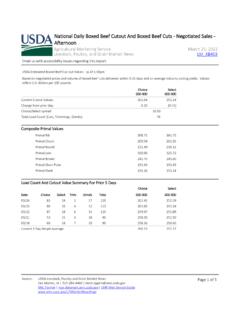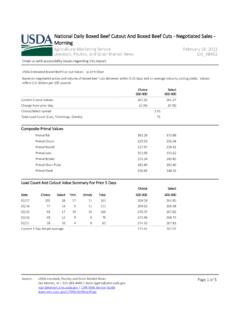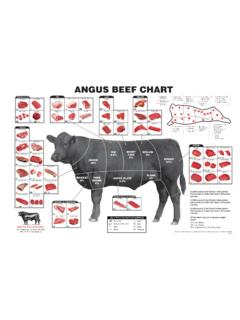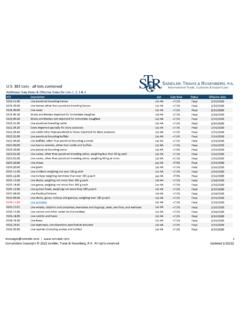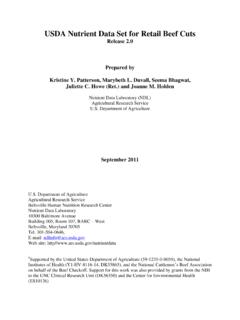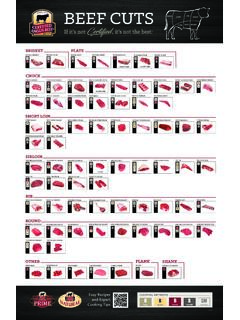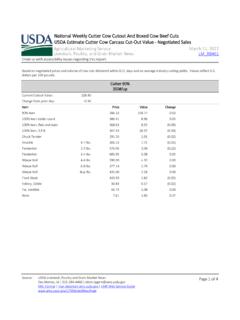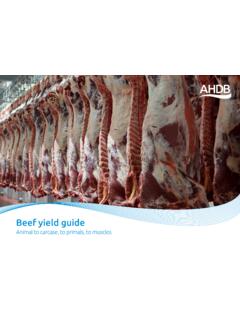Transcription of HOW MUCH MEAT TO EXPECT FROM A BEEF CARCASS
1 PB 1822 HOW MUCH MEAT TO EXPECT FROM A beef CARCASSU niversity of Tennessee Institute of AgricultureRob Holland, Director Center for Profitable AgricultureDwight Loveday, Associate Professor Department of Food Science and TechnologyKevin Ferguson UT Extension Area Specialist-Farm ManagementUniversity of Tennessee Institute of CARCASS and Primal Meat Affecting Yield of Retail cuts Amount of Meat from Each Sub-primal of Tennessee Institute of Agriculture2 IntroductionConsumers who buy a live animal from a local cattle producer for custom processing are often surprised. Some are surprised at the quantity of meat and amount of freezer space they need. Others may be surprised that they did not get the entire live weight of the animal in meat cuts . The amount of meat actually available from a beef animal is a frequent source of misunderstanding between consumers, processors and cattle producers.
2 This document provides information to assist in the understanding of how much meat to EXPECT from a beef CARCASS . The information provided here should be helpful to consumers who purchase a live animal for freezer beef and to cattle producers involved in direct and retail meat of Tennessee Institute of Agriculture3 How Much Meat to EXPECT from a beef CarcassDressing PercentageOne of the terms used in the cattle and meat cutting industry that often leads to misunderstanding is dressing percentage. The dressing percentage is the portion of the live animal weight that results in the hot CARCASS . The dressing percentage is calculated as:(hot CARCASS weight the live animal weight) 100 The hot CARCASS weight (HCW) is the weight of the unchilled CARCASS in pounds after the head, hide and internal organs have been removed.
3 For most fed cattle, the HCW will be approximately 60 to 64 percent of the live animal slaughter weight. However, the HCW can vary greatly from one animal to a 1,200-pound animal with a hot CARCASS weight of 750 pounds, the dressing percentage is and calculated as follows: (750 hot CARCASS weight 1,200-pound live weight) 100 = percentIt is not uncommon for the buyer of a live animal to say, The dressing percentage of my 1,200-pound steer was percent but I only got 450 pounds of meat where is the rest of the meat? The calculation of dressing percentage is based on the hot CARCASS weight. The hot CARCASS weight includes bone, excess fat and moisture loss that will not be packed and wrapped for home consumption. The hot CARCASS weight is not the amount of meat that the consumer will put in his or her freezer.
4 Many factors can affect the dressing percentage. Anything that adds to the weight of the live animal but does not appear on the CARCASS will lower the dressing percentage. Items that might add to the live animal weight but not be included in the hot CARCASS weight include: Hide Horns Gut fill Pregnancy Mud and or manure on the hideAll beef animals are not the same. Therefore, the dressing percentage will change from one animal type to another. Some of the primary factors that influence the dressing percentage include the type of animal in terms of breed, live weight and how it was finished. Table 1 shows the relative average dressing percentage for various types of beef animals and conditions. Even though the factors used to calculate dressing percentage are standard (live animal weight and hot CARCASS weight), there are variations in how and when each of these weights are recorded.
5 The live animal weight can vary depending on whether the live animal weight was recorded on the farm prior to transportation to the harvesting facility or immediately prior to harvesting at the harvest facility. Also, the hot CARCASS weight is the weight of the CARCASS before it is chilled. A beef CARCASS is 70 to 75 percent water. As it is chilled, water evaporation will cause the CARCASS weight to decrease. If the CARCASS weight used to calculate dressing percentage is the chilled CARCASS weight, then the dressing percentage will be lower than if the hot CARCASS weight had been used. It is not uncommon for a chilled CARCASS to weigh 2 to 5 percent less than the hot CARCASS . That is, a 750-pound hot CARCASS may lose 20 pounds or more in evaporation in the first 24 hours of chilling.
6 Table 1. Average Dressing Percentages for Various Types of CattleType/Condition of beef AnimalRelative Dressing PercentageTraditional Feedlot beef Type62-64 percentRestricted Feed Prior to WeighingHigherCattle Weighed Without Gut FillHigherOver-finished (fat) beef TypeHigherUnder-finished (thin) beef TypeLowerGrass finishedLowerDairy TypeLowerPregnant HeiferLowerMature CowLowerCattle Weighed With Gut FillLower4 RibChuckLoinFlankShort (kidney, hanging tinder, fat and cutting losses)All percentages are based off of total hot carcassUniversity of Tennessee Institute of Agriculture5 How Much Meat to EXPECT from a beef CarcassChilled CARCASS and Primal CutsThe term dressing percentage is often used in the meat industry and around harvesting facilities.
7 However, it is important to understand that dressing percentage alone does not give an accurate estimate of how much meat will be available for a consumer s freezer. After a CARCASS is cooled, it will be further processed into cuts of meat. The whole animal CARCASS will be cut into halves, and then each half will be separated into the hind and front quarters. Each quarter is then separated into primal (or wholesale) cuts . This process is referred to as breaking down the CARCASS . beef primal cuts in the front-quarter are the rib chuck, shank, brisket and plate; the hind quarter is composed of the flank, round and loin (short loin and sirloin). Figure 1 shows the typical weights and percent of a chilled CARCASS for the various primal cuts of beef from a 1,200-pound live steer and a 750-pound hot CARCASS .
8 The round, loin, rib and chuck are the major beef primals and are referred to as the thick cuts . The other primals are referred to as the thin 1. Typical Weights and Percent of a Chilled CARCASS for the Various Primal cuts of beef from a 1,200-pound Live Steer (750-pound hot CARCASS ). University of Tennessee Institute of Agriculture6 Sub-primal Meat CutsPrimal cuts will be further processed into sub-primals or into retail cuts . The basic concept of cutting beef retail cuts is to separate tender muscles from less tender muscles, to separate thick muscles from thin muscles and to separate fatter from leaner portions. For example, according to the publication titled beef cuts : Primal & Sub-primal Weights and Yields produced by the National Cattlemen s beef Association, the round typically makes up 22 percent of the hot CARCASS for a 750-pound CARCASS , the round would be approximately 165 pounds.
9 The round may be further cut into 132 pounds of meat that will be packed and wrapped for consumption. That is, approximately 20 percent of the round is lost to fat and bone. The round can be fabricated into the following four sub-primal cuts plus ground beef trimmings and stew meat: Top round Bottom round Eye of round Tip (Knuckle) Ground beef Stew meatFactors Affecting Yield of Retail cuts There are several factors that can influence the amount of meat that will be wrapped for the freezer. Some of the more common factors and an explanation of each are provided below: CARCASS Fat External CARCASS fatness has the greatest impact on the percent retail product from a CARCASS . As more fat is trimmed away from the retail cuts , less weight will be in the packaged meat and consequently a lower percentage of retail cuts from the CARCASS .
10 CARCASS muscularity Superior CARCASS muscling can increase the percentage of retail product. Dairy-type animals with lower lean-to-bone ratios typically yield lower than beef -type animals. Considering CARCASS fat and CARCASS muscularity, CARCASS fat has greater impact on decreasing yield than CARCASS muscularity s impact on increasing yield. Cutting style Cutting style or the cutting directions given to the processor can affect CARCASS yields. The major effects of cutting style can be explained by the amount of bone-in versus boneless cuts , trimming of retail cuts and the amount of fat in the ground beef . Because bone can weigh quite a lot, the more bone that is left in retail cuts results in more packaged meat weight and thus an increase in percentage yield.


